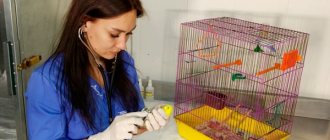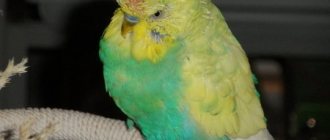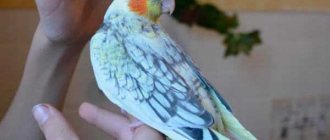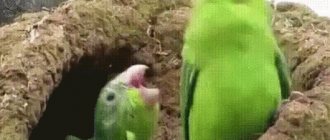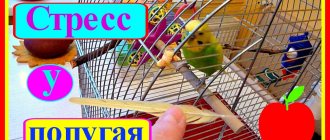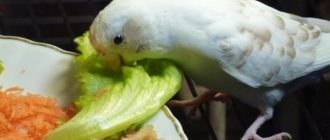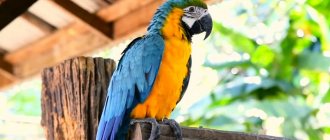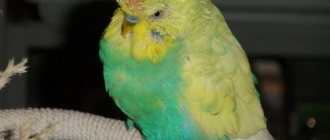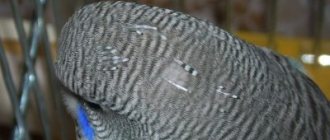- home
- Parrot
- Treatment
05/22/2019 Parrots have been considered one of the favorite pets for many years. They delight with their talent, sociability, and beauty. Those people who have adopted parrots note a change in mood from sad to joyful. However, these birds have one problem.
The fast metabolism of our feathered friends plays a “good” joke on them. Sometimes the bird's meal lasts for a whole day. Sometimes she may start eating out of the blue.
If your parrot eats a lot, it can be explained by a simple reason: stress.
Changing your diet depending on the time of year
In autumn-winter, it is advisable to add young green branches of fruit trees (cherry, plum, apple tree), as well as decorative deciduous trees (rowan, birch or linden) to the parrot’s diet. These twigs contain vitamins and tannins; they will be an excellent addition to green and grain foods.
In winter and spring, it is recommended to treat your pet with pine or spruce needles. The needles can be crushed and added as an additive to the main feed. Alternatively, you can hang a whole branch in a cage. Conifer needles contain a lot of essential oils and resins, and an excess of them can have a detrimental effect on your feathered friend. Remember that the daily intake of pine needles should be about 5% of total food intake. That is why it is necessary to give pine needles no more than 2 times a week.
Causes of obesity
- Heredity.
- Sedentary lifestyle.
- Overeating, exceeding the daily grain intake.
- Poor nutrition, high content of oilseeds in grain feed.
- Wrong cage (too small).
- Metabolic disease.
- Consumption of prohibited foods.
Parrots that live in flocks
often If you have several parrots in a cage, some of them may become obese due to overeating.
A parrot sleeps all day: how to organize a normal sleep schedule
To normalize your feathered pet's sleep patterns, take into account the summer and winter seasons. In the warm season, the sun stays at its zenith for a long time. And if you usually wake up at 7 o'clock in the morning, you need to cover the cage with a blanket at 21 o'clock in the evening. Then the parrot will sleep for the required 10 hours.
In winter, a parrot can sleep longer. Since it gets dark outside the window earlier, the cage can be covered as early as 5 pm. If you wake up at 7 am, he will sleep for 14 hours. This time is enough for the bird to be cheerful and cheerful throughout the day.
Remember that if your budgie sleeps a lot, this does not always indicate illness. Perhaps his regime should simply be adjusted.
Does a budgie need a mate?
Life in the wild
The birthplace of budgerigars is Australia. In the wild, these birds usually live no more than four years. Everywhere they are pursued by danger - predators, drought. Parrots have to travel vast distances in search of water, food, and safe places to raise their chicks. What helps them overcome these difficulties? Reaction speed, mutual assistance and team spirit.
In nature, wavy birds live in huge flocks. One parrot can instantly warn a thousand parrots about the approach of a bird of prey. But even in such a large company, the budgie will find its soul mate and will not confuse the color of its plumage with any other.
Domestic budgies are very different from wild ones. But they are related by ancient instincts. In megacities, wavy birds that have flown away from their owners are trying to form flocks with other birds and survive according to the precepts of sunny Australia. How are things going at home? Do parrots need the company of their relatives?
At home
At home, budgerigars live much longer, from 5 to 15 years. With a caring owner, the parrot is protected from natural disasters, the need to spend all its energy searching for food and escaping from predators.
The longest-living record holder among wavy fish lived for 21 years. Why is there such a discrepancy in numbers? Much depends on genetics, individual characteristics, and quality of maintenance. For example, if the parents of your feathered pet are from the same owner, they may be relatives. Their offspring do not have the best heredity. It is advisable that the feathered father and mother of your wavy friend are from different cities.
Proper care and healthy nutrition are the basis for the well-being and longevity of your feathered companion. Organize the space in the cage so that the parrot has room to climb, play, walk and play around.
Budgerigars live a long time if their owners communicate with them sincerely and kindly every day. Remember that the budgie talks. Refrain from using abusive language in his presence. It’s better to teach your feathered friend to call you by name, say hello, say good morning, and give compliments. With such a companion you will forget about boredom and despondency. But loneliness and boredom will not do the bird any good. If you are often away from home and your parrot is left to its own devices, consider finding a companion for it.
Pros and cons of pair housing
Even the most caring and sociable owner in the world cannot replace a budgie’s communication with its own kind. Surveys on thematic resources and forums show that the majority of budgerigar lovers keep one parrot. Although living with another parrot is more natural for this species.
Does a budgie need a mate? Let's look at two situations. You spend a lot of time at home and love to interact with your pet. Then one budgerigar will suit you just fine. You can have a conversation with him every time you have a free minute. And he will never get bored!
Option two. From morning until late evening there is no one at home. A lonely parrot will feel abandoned and may become depressed. A sure sign of the onset of depression is when a parrot begins to pluck its feathers. Then he definitely needs a friend or girlfriend. They will be able to spend time together, play, communicate and not feel abandoned.
But keeping budgies in pairs means there will be more noise from your feathered friends. They will need a large cage so that both can spread their wings at the same time without hitting the bars. You will need two copies of any toy for parrots. These birds are very jealous and can start a quarrel over a toy. Set up two feeders or a large feeder for two so that neither pet feels left out.
If a male and female budgerigar are paired, sooner or later they will want to have chicks. To do this, a pair of parrots must have a house in a cage, and their diet must contain protein food. If breeding wavy birds is not part of your plans, you should immediately choose a friend of the same sex for your ward. It's easy to distinguish. The cere - the part of the skin at the base of the beak - is sky blue in males. And in females it is pale brown.
Experts unanimously say that wavy birds live longer in pairs. The presence of a parrot friend (or girlfriend) nearby contributes to the longevity of the pet. But there are many other factors that also affect life expectancy. So we cannot say with certainty that a parrot that has a pair will definitely live two or three years longer than a single budgerigar.
Finding a suitable match for a parrot is another way to make your beloved bird’s life happier and longer.
How to choose a pair for a wavy
How to choose a mate for a budgie? If you initially choose a pair of parrots, take a closer look at their behavior in the cage. Often budgies find love or lifelong friendship in a pet store. Don't separate these couples. If you need one parrot, look for one that keeps to itself. This is a sign - it is you who will save the wavy from loneliness.
Please note that having a pair of budgies in the house at the same time usually results in them being difficult to tame. Why should they strengthen their friendship with their owners if they are already having fun together? To avoid this situation, first get a feathered boy and establish communication with him. After some time, you can start looking for a girlfriend or boyfriend for him.
If you decide to choose a friend or lady of your heart for your feathered pet, follow simple rules. It is better if both parrots are similar in color. Consider the temperament and age of your ward. Active and energetic people need the same companions. If your parrot is quiet and melancholy, a budgie with a similar personality will be great company. In an opposite-sex pair, the male should be two to three years older than the female. Otherwise, the adult feathered lady will begin to tyrannize the youngster.
The main thing is to give the parrots time to get to know each other and take a closer look at each other. After purchase, quarantine for two to three weeks. Let the parrots live in different rooms. Set up their cages on the same level and place the cages side by side for a few days. Start taming the second parakeet, and then place the second parakeet in a large cage with the first. Breeders say that it is better to place a female with a male than vice versa.
We wish your parrots strong friendship, happiness and longevity!
Why does cockatiel eat a lot?
The amount of feed may depend on the bird's temperament. More active individuals eat more. Calm, sedentary parrots consume few calories, and therefore their need for food is less. However, it is important to remember that there is a limit to everything, because if a cockatiel parrot constantly eats in large quantities, then this is a reason to be wary.
If you limit the amount of food your parrot can eat, he may start eating in reserve because he will be afraid of the lack of food. Give food regularly in the right quantity, it is necessary that it is constantly available.
When solving the problem of why the cockatiel constantly eats, make sure that the nutritional value of the food corresponds to the age of the bird. This will ensure normal growth and development. If an adult bird is given food for small parrots, it will not have enough vitamins. This threatens the appearance of vitamin deficiency. Then the cockatiel eats a lot to compensate for the lack of vitamins and microelements.
Beak diseases
The most common beak disease is overgrowth. However, this is not an independent disease, but a symptom complex associated with a large number of pathologies. The causes of beak overgrowth or curvature can be infectious diseases, for example: circovirus infection, cryptococcosis, mycobacteriosis, aspergillosis. Behavioral disorders caused by both improper maintenance (example: a cramped cage provokes constant gnawing of the cage bars and this leads to one-sided deformation or chips on the beak), and improper feeding of parrot chicks, which leads to mental disorders. Also, with the wrong method of feeding chicks of large and medium-sized parrots (jacots, macaws, amazons, cockatoos, eclectus), deformation of the jaw bones occurs, the beak is shifted to the side. If this problem is not solved in time, then the bird will remain with a crooked beak for the rest of its life, which in the future leads to problems with the spine and all the ensuing complications.
In budgerigars, the most common cause of beak deformation is scabies (scabies are described below in the “parasites” section) and chronic staphylococcal infection. With staphylococcosis of budgerigars, the beak remains shiny in appearance, but begins to grow very quickly, and dark longitudinal stripes or spots appear at the tip of the beak. The same spots may appear on the tips of the claws.
Therefore, if you notice that the parrot's beak is growing too quickly or is bent, it is not enough to simply sharpen or trim it, a full examination of the bird is required.
Helminth damage
If the parrot eats, but loses weight, then the cause may be helminthiasis or invasive infection of the parrot by worms. Accompanied by indigestion with the appearance of diarrhea. The presence of general lethargy and weakness. Lack of appetite or complete refusal to eat, weight loss, constipation.
The development of the disease occurs rapidly. Developing in the gastrointestinal tract, helminths injure the mucous membrane. Eating worms with overcooked food leads to a deficiency of nutrients and vitamins, which is a consequence of the bird losing weight. Intoxication of the body as a result of the vital activity of worms weakens the overall immune system.
Hide new food and have your parrot get it.
For example, wrap small pieces of new foods in paper bags, like candy. Make such bags not only with new food, but also with food already familiar to the bird. And put a handful of these hidden treats in a feeder or cup. The bird will happily rummage through such pieces of paper and unfold them, finding treats.
There are also special toys for parrots (for getting food) - educational toys. The principle of their operation is based on the parrot solving a puzzle, solving a problem in order to gain access to the desired goodies.
Contagious diseases
Parrots suffer from a large number of infectious diseases. Some infections are common to humans and parrots. Such infections are called zooanthroponoses. Owners of parrots need to know that humans pose a great danger to the parrot, because most of the normal human microflora (bacteria that live in the mouth and on the skin) is dangerous for parrots because it causes them to develop acute and chronic infections, such as escherichiosis, staphylococcosis. For this reason, humans need to avoid kissing and mouth feeding parrots. Infectious diseases of parrots that are dangerous to humans are very common, so you need to get tested for these infections immediately after purchasing a parrot, or better yet, before purchasing a bird.
Signs of contagious diseases in parrots and parakeets are varied, but none of them are specific. Those. It’s impossible to say for sure - if a parrot has discharge from the nostrils, then this is, for example, psittacosis, etc. Symptoms depend on which organ system is most affected, and if the infection develops in all organs of the bird, then multiple organ failure develops and all the symptoms of a sick parrot can appear at the same time - most often this is frizz, decreased activity, refusal to eat.
If the bird has just arrived at a new home
Many of the parrots in their new home do not eat or drink after purchase.
Leave the bird alone, let it look around, find food and water. During daily feeding and cage cleaning procedures, speak to your bird in a calm and gentle tone.
The adaptation time depends on you and the condition of the bird. If the bird is healthy, most likely in a couple of days it will begin to chirp cheerfully, study its cage, and toys .
There have been cases when parrots were taken by new owners, brought home, and they immediately began to look for food and chirp (but this applies more likely to older birds, which are about 3 months old).
And sometimes it happens that the chick sits silently for several days, ruffled, practically not moving in one place, this requires your patience and observation.
The adaptation period goes much faster when the bird is left alone and calms down. Usually in the evening or morning, when the lights are dimmed, the calmed bird decides to explore its cage. At such moments it is better not to disturb her. And under no circumstances should you come close to the cage or look closely at the birds.
Praise your parrot generously for simply touching new food.
Make sure your pet understands that you are happy when he even touches new foods. Touching is the first step to food, even if the bird is just throwing food out of the feeder rather than eating it.
The first obstacle in accustoming a winged bird to new types of food is that the owner himself gives up and does not try to offer it to the bird again and again. Pediatricians tell parents: Offer a new food to your children at least fifteen times before you come to the conclusion that the children really don't like the food. So offer your pet a new food that he refused again after a while. Only one thing can be guaranteed for sure - your parrot will not try to eat something unless you offer it to him.
Be creative and never give up!!!
Why does a parrot refuse to eat?
However, it is worth understanding that, like larger pets, parrots require constant care, communication, and attention. In addition, it is always difficult to avoid unexpected illnesses. And the owner of a feathered pet needs to have information about how to treat it, what to do if the parrot does not eat or drink. Reasons that may cause a parrot to be reluctant to eat:
- Stress when changing location.
- Poor quality food. You should not buy food from an unknown manufacturer for your parrot. It is also worth checking the expiration date.
- Poisoning or some other disease.
- Injuries received.
The parrot refuses to eat in a new place
If you have recently acquired a pet, then, like people, it is going through the process of adapting to a new place. In this situation, it is possible that the bird stops eating and drinking because it is experiencing stress from changing its habitat. In such a situation, you should not immediately panic. The parrot needs to be given a little time to get used to it and adapt to the new environment.
The following steps will help improve the adaptation process:
- in the room where the parrot is located, it is advisable to maintain silence, avoid sharp, loud screams, loudly operating home appliances,
- do not try to immediately establish contact with your feathered friend, let him get used to you,
- purchase several sets of drinkers and feeders and place them around the cage so that the parrot can figure out where the food, water,
- You should not let the bird out of the cage in the first days until it gets used to its new home.
Why doesn't my parrot eat in normal conditions?
If your pet, who has been living in the same territory with you for a long time, has stopped eating and drinking, then you need to look for the reasons for such changes. The owner should carefully monitor the bird’s behavior, appearance, and droppings. If you see visually unusual behavior of your pet, a manifestation of lethargy, or there are obvious changes in the bird’s droppings, then in this situation it is worth calling a specialist for help. He will be able to do the necessary tests to determine the reason for the reluctance to eat.
If your parrot shows signs of poisoning, then it is necessary to switch to a diet. Children's dairy-free porridges are best suited for feeding your feathered pet. There is an opinion that you should not force feed your feathered pet. However, if your parrot does not eat at all for two days, then measures must be taken to provide the small body with some nutrients. If the bird refuses to eat baby formula, then you can try giving small doses of complementary foods using a syringe without a needle. To do this, the porridge is introduced into the feathered friend's beak, drop by drop, from the side. This technique must be repeated systematically so that at intervals of no more than three hours the parrot receives a small dose of food.
Owners of feathered pets also suggest that in case of poisoning, give the parrot adsorbents, which must be diluted with a double portion of water. Such drugs include Enterosgel, Smecta, Polyphepan. However, I remind you once again that it is better to make such a decision about treating your pet together with a veterinarian. To feed your parrot, you should choose expensive food that contains iodine. Mixtures containing this element are classified as medicinal complementary foods.
Features of the cockatiel's body
In parrots, the digestive system is structured differently than in humans, so many nutrients are simply not able to be broken down, which can cause various problems with the bird’s digestion. That is why you cannot feed a parrot from your table; your pet’s menu must be compiled separately, based on the characteristics of its body.
The metabolic rate of parrots is higher than that of humans, so under no circumstances should your parrot be allowed to starve. Without food for even 1-3 days can be fatal.
For a Corella parrot, 3 teaspoons of grain mixture and a small amount of vegetables, fruits, sprouted grains, and protein products are enough per day. During the nesting and growing season, parrots often eat a little more. The amount of food consumed may also change up or down during molting. Feed a little more than normal because cockatiels, like many parakeets, like to throw food around. This is a kind of entertainment for them.
If your parrot doesn't drink water
There are often situations when the owner simply does not see when his pet drinks water. Parrots can also get enough water from fruits and vegetables.
If the owner is sure that the pet does not drink water, then this may be caused by:
- stress due to a change of home,
- poor water quality,
- low or high water temperature,
- inconvenient location of the drinking bowl.
It is advisable to select water for parrots in the children's nutrition department. This water is purified and has an optimal composition of nutrients. Filtered water is also suitable for your feathered pet. You can add a drop of lemon juice to this water to strengthen the body’s strength or a drop of honey. You should not give your parrot running water, because it may contain chlorine and dangerous bacteria. Also, feathered pets should not be given carbonated or mineral water.
Dehydration in parrots occurs within a day, so you should take a close look at your pet. If there is not enough water in the body, then this will immediately be reflected in the condition and behavior of the parrot. If the bird is active, there are no changes in behavior, and there are no external signs of illness, then there is no need to worry. A healthy, active feathered pet can become a true friend for its owner. Therefore, you should carefully choose food and water for your pet, and most importantly, find time to play and talk with him.
How much should a parrot eat?
The basis of the poultry diet is grain feed. The norm per day is 2 teaspoons. You can leave the entire portion in the feeder in the morning. Parrots are not known for their gluttony. They will not eat more than the body needs at one time. But they can spoil the feed, which increases its consumption. Therefore, it is better to divide the daily food into several meals.
There are no restrictions on the consumption of vegetables and fruits for parrots; they can be eaten as much as the bird wants.
It is imperative to change the water in the drinking bowl. A healthy bird eats all the food and does not give up its favorite dessert. If she does not want to eat some food or does not eat anything at all, you should take a closer look at her and identify the reason for this behavior.
Nerves, nerves and more nerves
The most common reason for this behavior is simple stress.
Now you will remember yourself, because there have almost certainly been situations in your life when you tried to relieve nervous tension with a delicious cake, or a portion of ice cream in front of the TV late in the evening.
And after all, this is a manifestation of the reaction of an adult, what then can we say about a small parrot?
After all, his life is full of different situations when he gets lost and begins to worry.
Such a situation could be moving to a new home, where everything is unusual and unfamiliar, or even the banal purchase of a new cage, in which the perch is so strange and unusual.
When experiencing stress, a parrot reacts to it in the same way as we do - it begins to eat a lot.
There are also opposite situations when the diet is greatly reduced due to the same reasons.
And don’t worry - this is an absolutely normal situation that will definitely pass over time.
Although if, along with an increase (or deterioration) in appetite, other anxiety syndromes occur, then it is better to consult a veterinarian.
